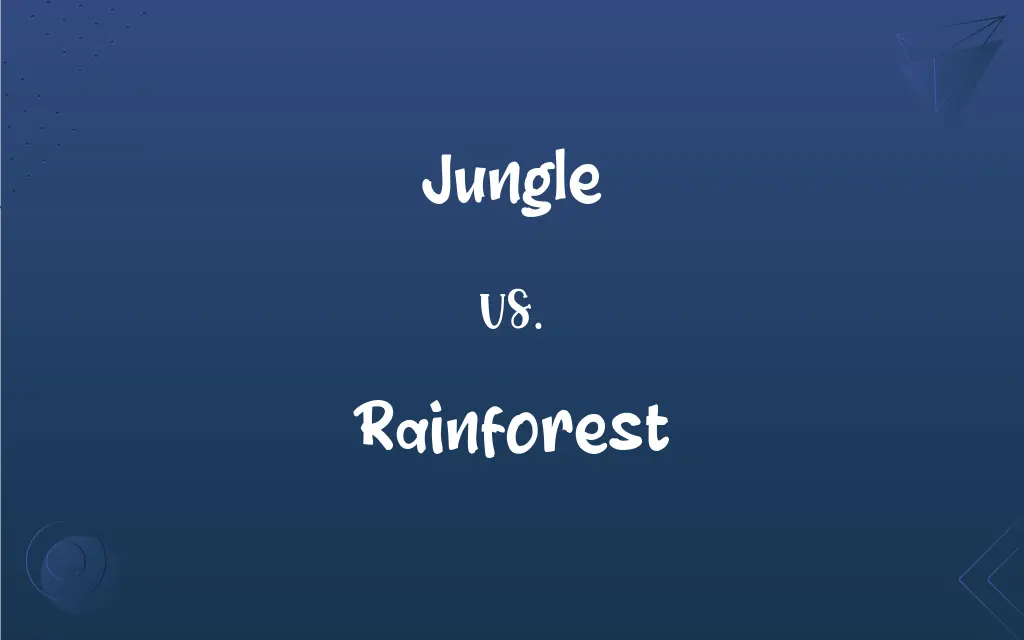Jungle vs. Rainforest: What's the Difference?
Edited by Aimie Carlson || By Harlon Moss || Published on February 4, 2024
Jungle refers to dense, wild, overgrown areas with thick vegetation, typically in warm climates. Rainforests are dense, biodiverse forests with high rainfall, often near the equator.

Key Differences
A jungle is often portrayed as a dense, tangled area with lush vegetation, primarily found in warm regions. In contrast, a rainforest is characterized by its incredibly rich biodiversity and significant amount of rainfall, typically located near the equator. While jungles are a subset of rainforests, the term "jungle" emphasizes the impenetrable nature of the vegetation.
When considering the flora, jungles are known for their dense undergrowth and can be part of both tropical and temperate rainforests. Rainforests, however, are defined by their layered structure, including the emergent, canopy, understory, and forest floor layers, supporting diverse wildlife and plant species.
Climate-wise, jungles are typically found in regions with a warm climate but do not necessarily have the high annual rainfall associated with rainforests. Rainforests, particularly tropical ones, receive a high amount of rainfall, often exceeding 2,000 mm per year, creating a unique and humid environment.
In terms of biodiversity, jungles are rich in species but are often less diverse than rainforests. Rainforests are among the most biodiverse ecosystems on Earth, housing a vast array of species, many of which are endemic and not found anywhere else.
When it comes to human interaction, jungles have often been portrayed as mysterious and unexplored in popular culture. Rainforests, while also subject to exploration and mystery, are primarily highlighted in discussions about conservation and the critical role they play in global ecology.
ADVERTISEMENT
Comparison Chart
Location
Warm regions, not necessarily equatorial
Typically near equator
Rainfall
Varies, not always high
High annual rainfall, often over 2,000 mm
Biodiversity
Rich, less diverse than rainforests
Extremely diverse, with many unique species
Vegetation Density
Dense undergrowth, wild appearance
Layered structure, dense canopy
Human Perception
Often seen as wild and mysterious
Known for biodiversity and conservation importance
ADVERTISEMENT
Jungle and Rainforest Definitions
Jungle
An impenetrable area of dense trees and underbrush.
The thick jungle made it difficult to find a path forward.
Rainforest
A dense, tropical forest with high annual rainfall.
The Amazon rainforest is home to an incredible variety of species.
Jungle
A dense, tangled area with lush, often tropical vegetation.
The explorer navigated through the jungle, surrounded by thick foliage.
Rainforest
An ecosystem rich in biodiversity and endemic species, sustained by frequent rain.
Scientists study the rainforest to understand its unique ecological dynamics.
Jungle
A wild, overgrown area with dense vegetation, typically in warmer climates.
They camped in the heart of the jungle, listening to the exotic sounds of wildlife.
Rainforest
A forest characterized by high humidity and a multilayered canopy.
Walking through the rainforest, they marveled at the towering trees and diverse wildlife.
Jungle
A place of intense competition or struggle for survival.
The corporate world is often described as a jungle.
Rainforest
A forest region known for its role in the Earth's oxygen production and carbon absorption.
The rainforest acts as a natural carbon sink, mitigating climate change.
Jungle
A complex or confusing situation, likened to a dense forest.
Navigating the city's bureaucracy was like wandering through a jungle.
Rainforest
A vital area for environmental and climate stability, often threatened by deforestation.
Conservationists emphasize the importance of protecting rainforests for the planet's health.
Jungle
Land covered with a dense growth of tropical vegetation.
Rainforest
A dense evergreen forest with a minimum annual rainfall of approximately 180 centimeters (71 inches). Rainforests are found chiefly in the tropics but also occur in temperate regions, where the rainfall amount is somewhat lower.
Jungle
A dense thicket or growth.
Rainforest
A forest in a climate with high annual rainfall and no dry season.
Rainforest
A forest with heavy annual rainfall
FAQs
What is the main difference between a jungle and a rainforest?
Jungles are characterized by dense vegetation, while rainforests are defined by their layered structure and high biodiversity.
Are all jungles tropical?
Not necessarily, jungles can exist in both tropical and temperate regions.
How much rainfall does a rainforest receive?
Rainforests receive high annual rainfall, often exceeding 2,000 mm.
Is deforestation a threat to jungles and rainforests?
Yes, deforestation poses a significant threat to both jungles and rainforests.
What defines a jungle?
A jungle is a dense, wild area with thick vegetation, often found in warm climates.
How do rainforests affect global climate?
Rainforests help regulate global climate by absorbing carbon dioxide and producing oxygen.
Do people live in jungles?
Yes, various indigenous communities live in and around jungle areas.
Can a jungle be part of a rainforest?
Yes, jungles can be parts of larger rainforest ecosystems.
Are jungles always hot?
Jungles are generally warm, but their temperature can vary depending on the region.
What types of animals live in rainforests?
Rainforests are home to a wide variety of animals, including birds, mammals, reptiles, and insects.
What are the main threats to rainforests?
Deforestation, climate change, and habitat destruction are major threats.
What is the understory layer in a rainforest?
The understory is a layer below the canopy, consisting of smaller trees and shrubs.
Why are rainforests important for the environment?
Rainforests play a crucial role in carbon absorption, oxygen production, and maintaining global biodiversity.
What is the canopy layer in a rainforest?
The canopy layer is the upper part of the forest, formed by the tops of high trees.
Are jungles important for biodiversity?
Yes, jungles contribute significantly to the biodiversity of their regions.
How are rainforests being conserved?
Through protected areas, sustainable practices, and international efforts to reduce deforestation.
How does the biodiversity in jungles compare to rainforests?
Jungles are biodiverse, but rainforests have even greater species diversity.
Can jungles be found outside the tropics?
Yes, there are temperate jungles in cooler climates.
How does rainfall in jungles compare to rainforests?
Rainfall in jungles can vary, but rainforests consistently receive high rainfall.
Are there different types of rainforests?
Yes, there are tropical and temperate rainforests.
About Author
Written by
Harlon MossHarlon is a seasoned quality moderator and accomplished content writer for Difference Wiki. An alumnus of the prestigious University of California, he earned his degree in Computer Science. Leveraging his academic background, Harlon brings a meticulous and informed perspective to his work, ensuring content accuracy and excellence.
Edited by
Aimie CarlsonAimie Carlson, holding a master's degree in English literature, is a fervent English language enthusiast. She lends her writing talents to Difference Wiki, a prominent website that specializes in comparisons, offering readers insightful analyses that both captivate and inform.






































































